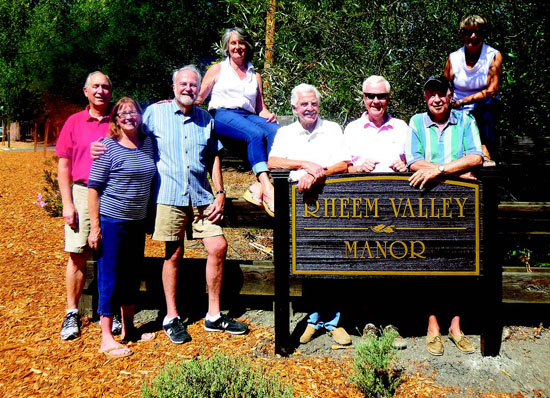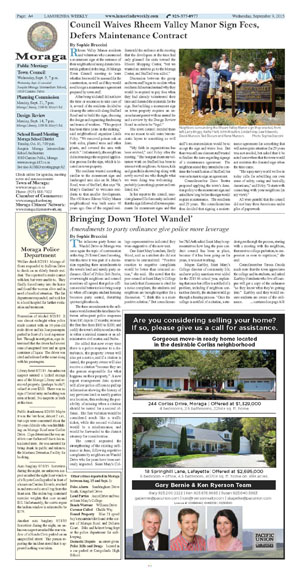|
|
Published September 9th, 2015
|
Council Waives Rheem Valley Manor Sign Fees, Defers Maintenance Contract
|
|
| By Sophie Braccini |
 |
| Neighbors surrounding the Rheem Valley Manor sign they erected, from left: Larry Briggs, Kathy Flett, John Moulton, Linda Foley, Lew Edwards, David Munson, Tad Slocum and Rena Munson. Photo Sophie Braccini |
Rheem Valley Manor residents and volunteers who constructed a monument sign at the entrance of their neighborhood using donated materials gathered at the Aug. 26 Moraga Town Council meeting to learn whether fees would be assessed for the construction, as well as if they would need to sign a maintenance agreement prepared by town staff.
 After being told staff did not have the time or resources to take care of it, several of the residents decided to clean up the entire side along Stafford Road and to build the sign, choosing the design and organizing fundraising and teams of workers. "This project has been three years in the making," said neighborhood organizer Linda Foley. "We removed poison oak on both sides, planted trees and other plants, and covered the area with mulch." Unfortunately, the neighbors did not undergo the required application process for the sign, which is located on town property.
After being told staff did not have the time or resources to take care of it, several of the residents decided to clean up the entire side along Stafford Road and to build the sign, choosing the design and organizing fundraising and teams of workers. "This project has been three years in the making," said neighborhood organizer Linda Foley. "We removed poison oak on both sides, planted trees and other plants, and covered the area with mulch." Unfortunately, the neighbors did not undergo the required application process for the sign, which is located on town property.
 The residents wanted something similar to the monument sign and landscaped area also on St. Mary's Road, west of Stafford, that says "St. Mary's Gardens" to welcome residents to that smaller development. The 450-home Rheem Valley Manor neighborhood was built some 40 years ago. One of the original residents told the audience at the meeting that the developers at the time had only planned for exits toward the Rheem Shopping Center, "but we wanted an outlet to go to the Moraga Center, and Stafford was added."
The residents wanted something similar to the monument sign and landscaped area also on St. Mary's Road, west of Stafford, that says "St. Mary's Gardens" to welcome residents to that smaller development. The 450-home Rheem Valley Manor neighborhood was built some 40 years ago. One of the original residents told the audience at the meeting that the developers at the time had only planned for exits toward the Rheem Shopping Center, "but we wanted an outlet to go to the Moraga Center, and Stafford was added."
 Discussion between the group and town staff began to escalate when residents did not understand why they would be required to pay fees when they had already volunteered their time and donated the materials for the sign. But building a monument sign on town property requires an encroachment permit with an annual fee and a review by the Design Review Board in order to be "legal."
Discussion between the group and town staff began to escalate when residents did not understand why they would be required to pay fees when they had already volunteered their time and donated the materials for the sign. But building a monument sign on town property requires an encroachment permit with an annual fee and a review by the Design Review Board in order to be "legal."
 The town council decided there was no reason to add extra bureaucratic layers to something so well done.
The town council decided there was no reason to add extra bureaucratic layers to something so well done.
 "My faith in organizations has been revived," said Foley after the meeting. "The best part about our volunteer work on Stafford has been to interact with neighbors. At times, kids and grandkids showed up along with newly-moved-ins who thought what we were doing was welcoming - probably (something) quaint and outdated, too."
"My faith in organizations has been revived," said Foley after the meeting. "The best part about our volunteer work on Stafford has been to interact with neighbors. At times, kids and grandkids showed up along with newly-moved-ins who thought what we were doing was welcoming - probably (something) quaint and outdated, too."
 In her report to the council, associate planner Ella Samonsky indicated that the sign followed all town requirements for monument signs and that staff's recommendation would be to accept the sign and waive fees. But there was still one element staff wanted to finalize: the issue regarding signage of a maintenance agreement. The neighbors stated they intended to continue the beautification of Stafford, but were reluctant to sign an agreement.
In her report to the council, associate planner Ella Samonsky indicated that the sign followed all town requirements for monument signs and that staff's recommendation would be to accept the sign and waive fees. But there was still one element staff wanted to finalize: the issue regarding signage of a maintenance agreement. The neighbors stated they intended to continue the beautification of Stafford, but were reluctant to sign an agreement.
 Councilmember Dave Trotter proposed applying the town's donation policy to the monument sign and asked how long before the sign would require maintenance. The residents said 25 years. The councilmembers then decided that signing a maintenance agreement for something that will not require attention for 25 years was not needed, but asked that it be noted somewhere that the town would not maintain the donated sign when the time came.
Councilmember Dave Trotter proposed applying the town's donation policy to the monument sign and asked how long before the sign would require maintenance. The residents said 25 years. The councilmembers then decided that signing a maintenance agreement for something that will not require attention for 25 years was not needed, but asked that it be noted somewhere that the town would not maintain the donated sign when the time came.
 "The topsy-turvy world we live in today calls for rebuilding our own sense of safety, caring and basically, Americana," said Foley. "It starts with connecting with your neighbors (in my view)."
"The topsy-turvy world we live in today calls for rebuilding our own sense of safety, caring and basically, Americana," said Foley. "It starts with connecting with your neighbors (in my view)."
 All were grateful that the council did not bury their Americana under piles of paperwork.
All were grateful that the council did not bury their Americana under piles of paperwork.

|
|
|
|
|
|
|
|
|
| |
|
|
|
|



